Streamer Fishing Simplified: Fly Fishing for Beginners
Written by: tct_hustle
Alright, so what are you going to tie on today? Maybe a circus peanut? Or a meat whistle? Heck, even a snot rocket could do the trick. Yeah, I know, sounds like I’ve had one too many beers, right? But hey, don’t knock streamer fishing—it’s a blast! And trust me, it’s not as complicated as it sounds and can produce some Large Fish.
Streamer fishing can be as simple or as complicated as you want to make it. You can grab your 9-foot 6-weight and a trusty woolly bugger, stroll out to the river, and catch fish. That’s one way to do it. Or you could get all fancy with a sink-tip line, your 1,000 $ spey rod, and all the latest streamers.
But here’s the deal: I going to simplify streamer fishing down to something that even a newbie can handle. No need to get overwhelmed—let’s just catch some fish.
#1: Pick the Right Fly
First things first: Picking the right streamer. Just like with nymphs, your goal is to imitate the food sources that trout find tasty. Streamers can mimic smaller trout, sculpins, baitfish, crayfish, leeches, or even big ol’ nymphs. And yeah, sometimes streamers just make fish angry enough to strike. But most of the time, you want your streamer to resemble something that trout might actually eat.
Here’s a pro tip that might sound a bit counterintuitive: If it’s a bright day, go with a bright fly. If it’s a dark day, pick a dark fly. It’s an age-old rule for a reason—it works. But don’t be afraid to mess around with colors, sizes, and shapes. See what gets those fish moving.
#2: Find That Streamer Water
Now that you’ve got the right fly, you need to find the right water. Streamers work best in deeper, slower runs and pools. Sure, riffles can be good, but that’s more dependent on the time of year. Focus on that ideal walk-speed water where trout like to hang out.
Streamer fishing means covering a ton of water. You want to get that fly in front of as many fish as possible. If a trout’s going to eat, it’ll usually do so on the first or second pass. So, if nothing bites, move on to the next spot. You won’t catch as many fish with streamers as you might with nymphs or dries, but your chances of landing a big one are way better. And who doesn’t want that monster trout to brag about?
#3: Cover Water Like a Pro
There are three main ways to cover water with streamers: the basic retrieve, the swing, and the dead drift.
The Basic Retrieve: Cast your streamer either slightly upstream or directly across from you to the opposite bank. Then, strip that line back towards you. Remember, you’re imitating food that might be wounded or trying to escape, so vary your strips—some fast, some slow. Mix it up!
The Swing: Cast straight across, hold the line tight, and let the fly swing with the current. Once it’s directly below you, give it a few strips. Fish often follow the streamer all the way to the end, so give it a little character to entice that reluctant trout.
The Dead Drift: This one’s basically nymphing with a streamer. Cast upstream, let it sink, and then just let it drift naturally. Add a little movement here and there to imitate a struggling baitfish. This is one of my favorite methods—it’s super effective, especially with crayfish patterns.
Break the Rules
Here’s the best part: There are no rules. Play around with everything—fly size, color, retrieve style. Swing it, strip it, dead drift it—whatever feels right. You never know what’s going to trigger a trout to strike, so don’t be afraid to experiment.
Streamer fishing doesn’t have to be rocket science. Tie on a woolly bugger, hit the water, and have some fun. Remember, there’s no right or wrong way to do it—just get out there and see what works.






